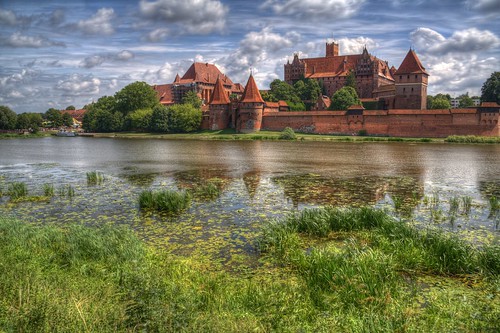Visiting Malbork! Posted by Kasia on Feb 20, 2014 in Places to visit
From Gdansk’s main rail station, Malbork is only 60km, 60 minutes away! If you’ve been in Gdańsk for longer than 2 days, set aside a few hours and make the short trip to this splendid edifice. There are many magnificent historical buildings in Gdańsk, but in Malbork you can see history in isolation. It’s just you and the castle, particularly if you go in the early fall, after the crush of tourists has passed.
The history of Malbork begins in the Holy Land and by ‘Holy Land’ I mean Palestine, not the Krispy Kreme Donuts factory. Allow me to introduce you to the fabled Teutonic Knights, a rowdy band of monks with a lust for slayin’ and convertin’. After Palestine was lost to Islam, these zealots needed a new base of operations. But the Crusades were partly an excuse to get people like this out of Europe, so no one wanted them back! Finally, a Polish King offered them sanctuary in return for help against some pagan Lithuanians. The Knights were happy to help, but they were also happy to form their own state and control the amber trade. Also, they massacred the citizens of Gdańsk in 1308, which they were supposed to be protecting. Whoops.
Obviously, these actions didn’t exactly sit well with the Polish King, who promptly allied himself with the Lithuanians who were being constantly raided by the Knights. In 1410, the massive battle of Grunwald saw the defeat of the Teutonic Knights, but the stumbling Polish King stalled out and was unable to rout them from Malbork, where they had been constructing and improving a massive castle since they first established themselves in the region over a hundred years prior. They called the castle Marienburg (St. Mary’s Stronghold) in case you hear that name, rather than Malbork.
The Teutonic Order continued to decline and in 1457 the mercenaries working for the Knights decided that it was a good idea to take the castle for themselves and sell it to the Polish King. Gotta get paid somehow, you know? Anyways, the Polish monarchy kept Malbork in decent shape for the next few centuries. Royal persons would rest their weary feet in its awesome rooms and vaulted hallways while travelling to and from Gdansk. Perhaps it was this leisurely attitude that led to the Partition of Poland in 1772, upon which the castle was controlled by the Prussian rulers.
Unfortunately, the Prussians turned the magnificent castle into a barracks and many of the out walls and towers were taken down, many windows were bricked up, and much of the splendor was lost. Of course this gradual decline and industrial transformation was preferred to the bombing, destruction, and looting done to the fortress by the Soviet army, and by the end of the Second World War, Malbork was basically a shadow of its former self.
Today, the castle has been renovated and reconstructed, as faithfully as was possible. In general, reconstruction work throughout Gdańsk and its neighbors has been incredible and Malbork is no exception. In 1997, the castle became a World Heritage Site. Bristling with weapons displays, the medieval historian inside all of us will revel in the sheer amount of exhibits and displays. There are also a great many amber exhibits, as well as entire rooms devoted to the Teutonic way of life. Half the fun is actually just running through the hundreds of empty corridors, imagining that there’s a battle going on, but for the kids there are some cool wooden weapons available for purchase.
The ‘Siege of the Malbork Castle’ is the biggest event of the summer, but there are a number of smaller fairs and festivals throughout the year. Tours are available in English, German, and Russian but will run you 150 PLN unless you organize something in advance. It takes a good 4 hours to see most of what’s inside, unless your hunting for some ghosts, in which case you’ll need more time to set up your equipment. Whatever your aims, you’ll be sure to leave the castle with a smile on your face and thoughts of forming a metal band named “Teutonic Pagan Slayer.”
Do następnego razu… (Till next time…)

Build vocabulary, practice pronunciation, and more with Transparent Language Online. Available anytime, anywhere, on any device.
About the Author: Kasia
My name is Kasia Scontsas. I grew near Lublin, Poland and moved to Warsaw to study International Business. I have passion for languages: any languages! Currently I live in New Hampshire. I enjoy skiing, kayaking, biking and paddle boarding. My husband speaks a little Polish, but our daughters are fluent in it! I wanted to make sure that they can communicate with their Polish relatives in our native language. Teaching them Polish since they were born was the best thing I could have given them! I have been writing about learning Polish language and culture for Transparent Language’s Polish Blog since 2010.





Comments:
John:
If you visit Poland Warsaw, Krakow, and Gdansk should be on the itinerary, but Malbork is also a must see destination. Of course educated toilet facts are always memorable and this place is no exception. The defecation holes were strategically located so the waste would fall into the moats, along with the cabbage leaves used as toilet paper. The construction of the complex is amazing.
Joy @MyTravelingJoys:
My husband and I loved visiting Malbork in August as part of our Polish road trip! I only wish we would have coordinated our visit so we could have taken one of the English tours.
Robert:
I suggest travelling with GdanskShuttle.
Last year they took from us 120 euro for whole day trip.
We were travelling with 8 persons so it was 15 eur/ person – less than cost of tram, train and bus both sides.
And certainly more comfortable.
Their web-site:
http://gdanskshuttle.info